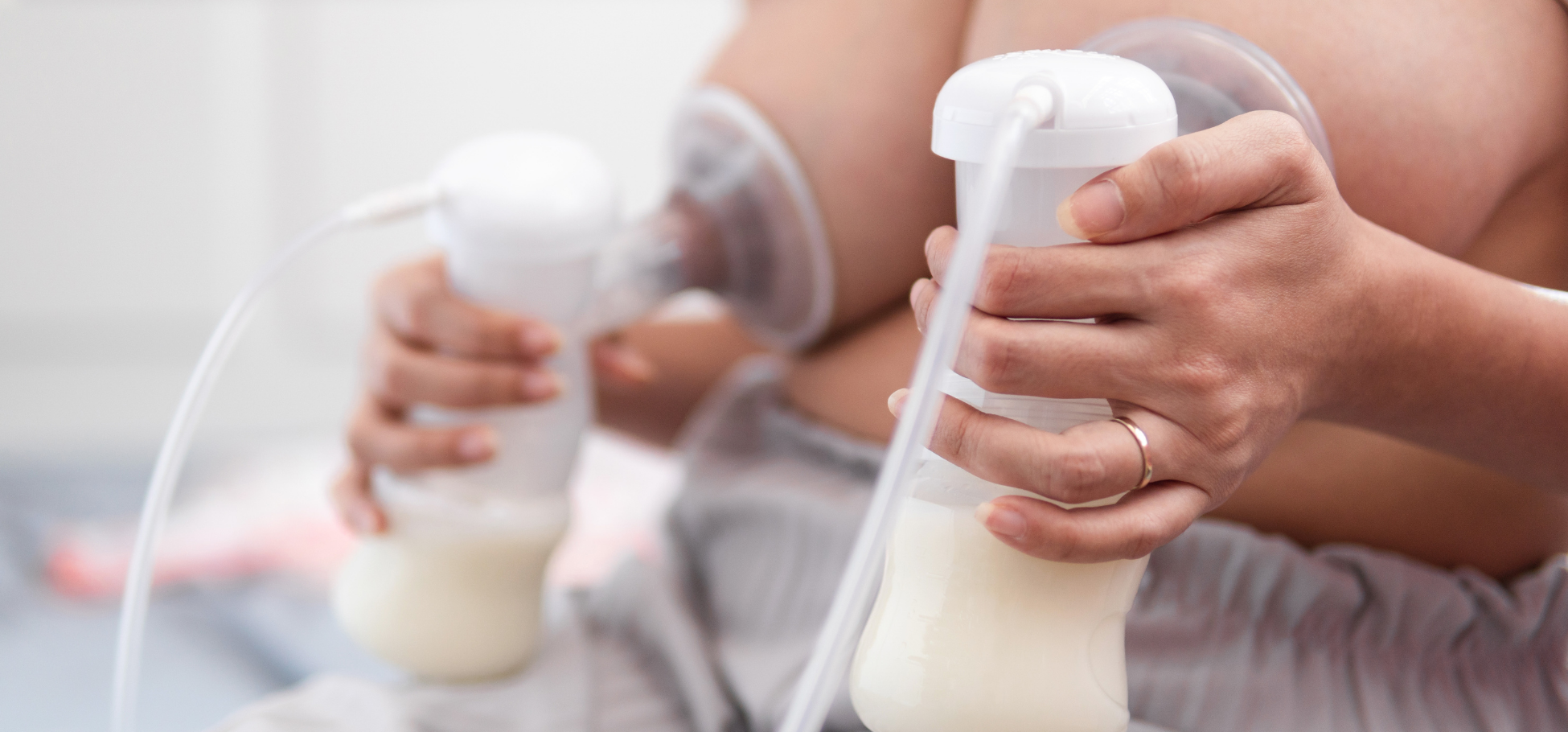In the months and weeks leading up to the birth of your baby, you’ll have a lot on your mind. It can feel like a very exciting and also very stressful time trying to get everything ready and tie up loose ends before your baby arrives. Luckily, breastfeeding is a natural process that you and your baby already know how to do – not that there aren’t frustrations that will come up along the way. The important thing to remember is that our bodies are meant to make milk, and even though every mother and baby have different experiences, breastfeeding is a completely normal process.
How to Prepare for Breastfeeding Success
- Tell everyone about your plan to breastfeed, especially your healthcare support staff at the hospital or birth center.
- Get recommendations for a lactation consultant before you need one. You may decide to call on a lactation consultant during the first few weeks if you experience breastfeeding problems like poor latching or low milk supply, and it’s nice to know who you’ll be able to call ahead of time.
- Look up the schedule for a local breastfeeding support group and clear your calendar during the meet-up times after your due date. Lactation groups are extremely beneficial for moms getting a handle on breastfeeding a new baby.
- Check to see if you are eligible to get a breast pump through insurance or Medicaid. Unless your baby is in need of expressed milk right after delivery, you won’t need your breast pump until you begin storing milk in preparation to return to work or using it while you are away from the baby. Don’t use it before delivery without consulting with a physician as it can cause you to go into labor prematurely.
- To view or download our Breastfeeding Timeline, click here.
When Does Breast Milk Come In?
Nursing mothers will likely face many of the biggest challenges during the first week of breastfeeding, but if you approach it confidently and with supportive helpers, you can make great strides toward breastfeeding success. After your baby is born, you’ll probably feel anxious about when your milk will come in, but just relax and let your body do the work. Before your milk comes in, your breasts will produce colostrum, which is a nutrient and immunity rich substance that is important for babies. This is enough for your baby before your mature milk comes in, because your baby’s stomach is the size of a blueberry at birth.
When your milk comes in, you may feel some uncomfortable engorgement at first. Feeding your baby on demand and offering your breast to the baby frequently can help your body begin to regulate your milk supply and adjust it to the level your baby needs.

Mastering the latch doesn’t usually happen right away and it is important to remember that it may take some patience to establish, especially if you have flat or inverted nipples. If you’re having pain while nursing, remember that pain is common but it isn’t normal. You should work with your lactation support person to resolve the issue causing the pain as soon as you can.
Take time to rest with your baby as much as possible during this time. Holding your baby ”skin-to skin” frequently is effective for helping establish a solid breastfeeding connection.
Establishing Breastfeeding Success During the “4th Trimester”
You're probably exhausted, you haven't showered, you don't know which way is up and which way is down. That's okay! During the "4th trimester" or postpartum recovery period, moms are just beginning to get a handle on life with their new baby. The most important thing is that you and baby are resting, well-fed, and spending lots of time cuddling. You may be feeling antsy to get back into old routines, but cross everything off your calendar and just relax and rest if you can! If you're experiencing any pain or discomfort during breastfeeding, fit in a visit with your lactation consultant to help resolve the issue. It can be as simple as finding new breastfeeding positions.
How Often Should I Breastfeed My Newborn?
Breastfeeding on demand or whenever your baby appears to be hungry, even if you just fed them, will help keep your baby happy. Nursing frequently can also help prevent engorgement of the milk ducts, which can lead to mastitis. Learn your baby’s unique hunger cues, as well as signs that she is full. Measuring the amount of milk your baby is getting is difficult during this time, but as long as your baby is healthy and growing, you don’t need to know exactly how many ounces are being consumed.
Stock up on breastfeeding supplies such as nursing pads and nipple cream so you can begin transitioning back into routines such as running errands and attending to responsibilities outside of the house without leaks and discomfort from sore nipples.
Wearing your baby in a sling, wrap, or carrier can make breastfeeding on the go easier. Some baby-wearing techniques support your baby’s head while giving them direct access to your breast and you can just go about whatever you are doing without stopping to nurse. Not to mention that wearing your baby gives you two free hands! You can even do chores around the house while wearing your baby if they insist on being held, as many babies do.
Sleeping Habits and Breastfeeding
Sleep is a big topic for new parents because having a newborn can throw everything off. It is very likely that you aren’t sleeping as well as you were before your baby arrived! Being overtired can amplify stress, postpartum depression, and cause emotions to run high, so try to stay grounded as you navigate life in a sleep-deprived state. Whether you are co-sleeping or putting your baby in a crib or cradle at night, you’re probably waking up frequently to breastfeed. During the first month, babies will have varying feeding habits. Some babies will sleep long stretches without waking to nurse and some want to nurse for hours at a time. As long as your baby is healthy, you shouldn’t worry about whether your baby is sticking to a “normal” routine.
Two Tips for Breastfeeding and Sleeping
- Some parents find that co-sleeping or having the baby in the room at night helps them get better sleep because they have less distance to travel to feed or comfort the baby. It is important to make this decision based on what makes you feel most comfortable.
- You can begin using your breast pump to store breast milk in order to give your partner the opportunity to feed the baby during the night. This can help your partner have bonding time and share the responsibilities of midnight infant feeding. It also gives you a chance to practice setting up and using your pump. It is important to consider waiting at least a few weeks after delivery to start doing this when breastfeeding and milk supply are well-established. Middle of the night breastfeeding feeds are really important in helping to build a milk supply.

Note: You may be eligible for new breast pump supplies such as tubing and bottles through your insurance every six weeks. It is good to have an extra set of supplies and to replace any damaged parts as soon as possible.
What is the Best Diet for Breastfeeding?
Nutrition for you is important during breastfeeding because your body is working hard to produce milk for the baby. You’re using a lot more calories than normal to make that milk and you want to make sure that you’re eating well and staying hydrated. Your baby may also have some reactions to certain foods you are eating through your milk. It is not uncommon for babies to have excess gas or discomfort from some trigger foods such as the brassica family, which includes broccoli, cabbage, kale, cauliflower, and brussels sprouts. Cow’s milk dairy products can also cause digestive problems for babies. If your baby is experiencing severe diaper rash, speak with your pediatrician about what may be causing it and something in your diet is the culprit.
Two Tips for Diet and Breast Milk
- There is an enzyme called lipase found in human milk that breaks down fats so your baby can digest them. Sometimes lipase is produced in excess and it causes your milk to have a strong odor or flavor. An excess of lipase isn’t dangerous for babies, but some will refuse to drink it. If you experience this problem, talk to your lactation consultant about what you can do to fix it. They can direct you in how to safely eliminate the taste from your milk.
-
Avoid excess caffeine and alcohol which may affect your baby’s sleep patterns. Caffeine has also been linked to colic and acid reflux in babies. Additionally, stay away from fish that may contain high levels of mercury.
Back to Work Breastfeeding Plan
One of the biggest concerns for new moms after having a baby is whether or not the transition back to work will go smoothly. The key to a successful transition is to create a plan and to find the breastfeeding cheerleaders in your life. International Board Certified Lactation Consultant Kathleen Kendall-Tackett recommends this template to address the major considerations you will encounter during the transition back to work. You can also find a helpful downloadable Back To Work Plan here.
This includes a list of supplies to take with you, what to provide your baby’s caregiver, how to set up a pumping space at work, and how to talk to your employer about it. If you are aware of the potential obstacles, you will be able to navigate around them more easily when they pop up.
Two Tips for Back to Work Breastfeeding
- Find Your Breastfeeding Cheerleaders
These people are the ones that keep your spirits up when you’re feeling overwhelmed or are doubting your ability to continue nursing. They can be family, friends, other moms at a breastfeeding support group, a lactation consultant, or your healthcare provider. Have their contact information ready in the event that you need a pep talk. - Don’t Plan to Pump in a Bathroom
The default pumping location used to be bathrooms, however, there are laws now that require companies to provide a private nursing space for breastfeeding mothers that isn’t a bathroom. While there are a few exceptions to the law, it is not too much to ask for a space that is NOT the bathroom. If your employer requests that you keep your pumping in the restrooms, kindly let them know that it is not standard practice anymore.


Breastfeeding in Public is a Right
Some moms find that breastfeeding in public is easy for them, whereas some mothers do not feel as comfortable with the idea. No matter how you feel about it, you will likely be faced with a time when breastfeeding in public is much easier than finding a place to nurse privately. In the United States, there are many laws protecting the right to breastfeed in public or even in private spaces such as businesses, airports, etc. If you are ever asked to stop breastfeeding by someone, let them know that you have the legal right to continue. Check out the laws state by state here.


Two Tips for Breastfeeding in Public
- If you feel uncomfortable or need to have privacy while breastfeeding, invest in a nursing scarf or wrap that can offer you coverage when there isn’t a private room available.
- As mentioned earlier, wearing your baby in a sling, wrap, or carrier can give your baby direct access to your breast with little to no interference to you going about your day.
Breastfeeding Changes for Baby and Mama
You may have noticed that your body and the baby's habits have changed steadily since the first weeks of breastfeeding. You have probably felt that your breasts are beginning to regulate your milk and you don't experience as much fullness as you used to. Don't worry, it doesn't mean that you aren't making enough milk, it just means your body is doing a better job matching your baby's appetite. Your baby has also started to get into the routine and is taking less time to nurse because they are more efficient at getting the milk out.
Two Tips for Breastfeeding Around the Third Month
- Most babies will still be waking up in the middle of the night to nurse at this age. This is normal and does not require sleep training to fix. Your baby is just hungry and wants to be fed. Although you may feel tired and frustrated with your own lack of sleep, just remember this phase of life won’t last forever. It is important for your baby to have nutrients and bonding time, even in the middle of the night.
- Your baby may develop a preference for one breast or only want to feed on one side during a nursing session. This is a good opportunity for you to pump on the opposite side to avoid becoming uncomfortably full, but also to store up milk for returning to work or spending time away from your baby.
What are the Benefits of Breastfeeding?
By the third and fourth months, breastfed babies have a lowered risk of Type 1 childhood diabetes and asthma. Additionally, you have given your baby valuable immunities and nutrients that will help them fight off infections and viruses more efficiently! Congratulations!
There are benefits for breastfeeding moms too. Breastfeeding helps reduce the risk for breast cancer and ovarian cancer and diabetes, according to the Centers for Disease Control (CDC).
Don't worry if your little one seems hungry all the time. There is a big growth spurt around the third and fourth months and they will be nursing more frequently. Your body should still be keeping up with demands and making enough milk to satisfy your baby's appetite. Talk to your lactation consultant or doctor before supplementation with infant formula if you are concerned about your milk production. They will be able to help you figure out if the baby is getting enough to eat. Looking for a Lactation Support Person? Use our helpful Lactation Support Directory to find one in your area!
The calories it takes to keep breastfeeding will help you shed some of the pregnancy weight that you gained. Between three and six months will be the most noticeable time for weight loss after pregnancy.
Preparing for Teething While Breastfeeding
During this time and for the next six months, babies will be preparing to cut their first teeth. The desire to chew on toys, drooling, and discomfort are par for the course. This does not mean that you need to quit nursing! Some babies will want to nurse more or less depending on whether breastfeeding bothers their gums or helps relieve pain. Every baby is different! When teething is in full swing, your baby may be waking more frequently in the night because of the pain. There are ways to help deal with it, and this phase won't last forever!
Three Tips for Dealing with Teething While Breastfeeding
- Give your baby access to safe, clean, soft rubber toys to help your baby satisfy their urge to chew. Have plenty on hand in case one falls on the floor and needs to be cleaned or carry a pacifier and toy cleaning wipes so you can quickly give it back to the baby to avoid fussing. The American Academy of Pediatrics and FDA recommend against the use of teething necklaces due to a risk of strangulation.
It is not recommended to give your baby any kind of benzocaine numbing gel due to health concerns and interference with breastfeeding.
If your baby tries to bite you while nursing, try offering them a toy to chew on. If you can’t get them to let go, slip your finger into the baby’s mouth, next to your nipple, and between their gums to loosen their grip. Talk to your lactation consultant about how to prevent biting and avoid injuries.


Solid Foods
Your baby may begin to show interest in food between 5-6 months, but there is no need to rush it if they are still just interested in nursing. Some babies don’t really get excited by solid foods until nine or ten months. You can begin experimenting with your baby “tasting” solid foods, but you don’t need to be giving them sizable portions. Additionally, it isn’t necessary to supplement your baby’s diet with water, juice, or cow’s milk if you are still breastfeeding. Breast milk should still be your baby’s primary food source for the first year of life. Solid foods should make up less than 25% of your baby’s diet by the time they reach twelve months old.
Two Tips for Complementing Breast Milk with Solid Foods
- Offer a taste of solid foods like banana, pureed fruits, or vegetables, and let them guide the process. If they don’t seem interested in the food, then don’t force them to eat it. Don’t be concerned if your baby isn’t interested, as they will develop the taste for solid food when they are ready.
- Give solid foods after you have nursed the baby so they aren’t tempted to eat too much. Babies don’t need to be eating a lot of solid food and if they eat too much, it can lead to early weaning even if you aren’t wanting to wean. Breast milk continues to provide benefits long after solids are introduced and can be given in tandem with solid foods for years.
Distraction, Teething, and Moving Around
Distraction
It is normal for your baby to be distracted during nursing sessions now that they’re attuned to the people, sights, and sounds around them. Their brains are growing quickly and they want to engage with their environment. This doesn’t mean that they are no longer interested in breastfeeding! It may require a little urging for your baby to focus enough to have a full feeding session.
Teething
Teething is in full swing at eight months and they are trying hard to cut those first teeth. You can continue to offer your baby safe rubber rings and frozen teething toys. It doesn’t mean that you need to stop breastfeeding when your baby’s teeth break through the gums. Babies can nurse successfully well after their teeth have grown in and not all babies go through a biting phase! Talk to your lactation consultant about methods to prevent biting and avoid injuries.
Moving Around
Your baby may be trying to army crawl, shuffle, or scoot at this age and for the next few months. This may be another distraction keeping your baby from wanting to nurse. Try to find a dark, quiet location to get nursing sessions in before letting your baby get distracted by things in the room.
How Long Should I Breastfeed My Baby?
The American Academy of Pediatrics (AAP) recommends breastfeeding for at least one year because of the nutritional and health benefits provided by breast milk. By this stage, your baby will have reduced risks of several childhood illnesses as well as improved cognitive abilities. Your baby will be eating solid food regularly now, but that doesn’t mean that breast milk is no longer valuable. Your breast milk still contains antibodies and healthy fats that help your baby grow.
Two Tips for Breastfeeding at One Year
- Comfort nursing is still popular among babies at one year. It is perfectly normal to nurse your baby if they are needing comfort or to be consoled after an accident or if they're upset. A few moments in mom’s arms can help a baby recover from a minor injury quickly and give them the confidence to return to whatever they were doing.
- Your baby may still be waking during the night to nurse or wanting to nurse to sleep. Many breastfeeding professionals agree that falling to sleep without nursing or sleeping through the night is a physiological milestone that babies will reach when they are ready. Just like walking and talking cannot be forced, sleeping through the night consistently isn’t a skill that can be learned; it has to be part of their development process. Babies can experience several sleep regressions throughout the first year of life. It is important to remember that it won’t last forever.
Growth Spurts and Breastfeeding
Breastfeeding as your baby becomes a toddler can seem increasingly challenging, but the value of your breast milk is still relevant! Babies go through yet another big growth spurt around fifteen months and they may be looking for more comfort and nursing sessions than usual. Your baby is a pro at latching and can nurse in every position – some call breastfeeding at this stage “gymnurstics” because babies will wiggle, dance, rotate, and do anything but sit still while at the breast.


Two Tips for Breastfeeding at Fifteen Months
- Some moms will attempt to night wean at this point if they haven’t already. Breastfeeding support professionals recommend reassuring your baby when bedtime comes around by lying with them, rubbing their back, and letting them know you are near. They may not like not falling asleep without nursing at first, but as long as they have someone comforting them, they will eventually fall asleep. If it feels very difficult for you or your baby, don’t feel pressured into doing it. You and your baby will find the right timing to change your routine.
- Moms who are planning to have another baby or have already become pregnant with their next child will wonder about the effects of pregnancy on breastfeeding. There are usually no problems associated with breastfeeding while pregnant, however, hormonal changes may make your breasts feel more sensitive and it is normal for your milk supply to drop a bit. This is not a big issue, because your toddler will be eating a diet of solid foods and water in addition to your breast milk.
Breast Milk Changes During the Second Year
During the second year of breastfeeding, your milk will change consistency and become more concentrated. Much like colostrum, the nutrients will be delivered more efficiently through smaller amounts. Additionally, your baby is very good at nursing and can drink more quickly. Breast milk is still a very important source of protein and nutrients that can help your child avoid illness and disease.
Two Tips for Nursing During the Second Year
- Babies will go through changes in nursing habits over the second year. Sometimes they will want to nurse constantly and sometimes very infrequently. This is normal.
- The human body is designed to breastfeed for up to seven years after you have your child. In our culture, breastfeeding typically winds down over the first few years, but remember that our bodies are designed to provide nutrients for much longer than that. Don’t feel pressured to wean your child if you aren’t ready to do so.











